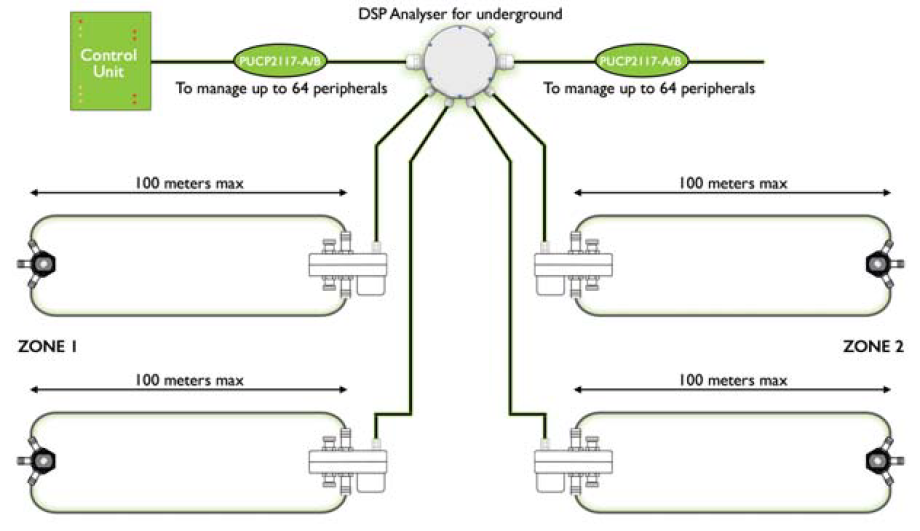GPS Plus
GPS Plus is a buried line differential pressure system suitable for the discreet perimeter protection of commercial, domestic, industrial, military or other high risk areas.
Invisible Perimeter Protection
GPS Plus is a buried line differential pressure system suitable for the discreet perimeter protection of commercial, domestic, industrial, military or other high risk areas.
Due to its unique concept GPS Plus can be used in all types of topography and, being buried, the entire system is completely invisible.
GPS Plus is a passive system and it is, therefore, impossible to ascertain the precise location even by using the most sophisticated detection and measuring equipment.
GPS Plus provides a high probability of detection combined with exceptionally low nuisance alarm rates.
Due to the fact that the entire design assembly is buried, it is protected from the effects of climatic deterioration or atmospheric interference and requires a minimum of maintenance.
GPS uses 2 specially formulated underground sensing tubes which are normally buried 25-30 cms deep and between 1-1.5 metres apart.
Once filled with liquid and pressurised, the tubes will detect and measure the differential change in pressure between them caused by an intruders approach.
This differential pressure change is converted to an electrical signal by the underground sensor.
The resultant signal is subjected to complex time and frequency domain analysis by the associated peripheral processor to determine whether it has reached the alarm thresholds and also whether it matches particular signal patterns.
When all the criteria are met the information is passed to a central Communications Processor unit which will interface into most alarm control and monitoring systems, using either relay contacts or serial interfaces.
GPS has been extensively tested and proven in its capability to detect intruders walking, running, jumping, rolling, attempting to bridge the system with planks or trying to dig underneath the sensor tubes.
Product Features
The GPS systems perform continuous hydraulic compensation between the two sensing tubes.
This automatically balances the pressure between them even when heavy loads are left over the system. This means that the system can be used without restricting the location of vehicles to outside the protected area.
The GPS system is unaffected by high voltage disturbances, electrical discharges, radio power transmitters etc.
The GPS system can be installed under most surfaces including sand, soil, gravel, paving slabs, asphalt etc. It is also able to cope with changes in surface within one protection zone. It should not be used under uninterrupted concrete areas.
The GPS system is practically unaffected by weather conditions (rain, wind, snow etc.) or temperature variation. The detailed signature analysis will automatically eliminate the background noise associated with these phenomena.
Provided the tubes are installed 3 to 4 metres from trees or heavy vegetation , the system is unaffected by them.
The inherent flexibility of the tube allows the system to easily follow ground contours, without altering its performance.
Approved for UK Government Use for details contact CPNI

Components
Tube
This is the underground pipe used to transmit the pressure signals to the sensor unit. A special synthetic mix is used to provide the correct elasticity factor and underground durability. It is filled with a low freezing point fluid.
Compensating Valves
These units are used to perform the self-compensation feature of the system and are connected to the opposite ends of the tube to the sensor units.
The body of the valve is of a special material suitable for direct burial without deterioration.
Cable
This is a 4 core fully screened, cable with protective outer sheath suitable for direct burial. It is used to connect the peripheral to the UCP.
Pressure Sensor / Transducer
Connects to the sensitive tubes and converts the differential pressure signals created by the tubes into electrical signals for analysis by the Peripheral. Can monitor a parallel pair of tubes for up to 100m.
Peripheral
This unit houses the micro-processor based electronics for the signal analysis. Supplied either in a direct burial housing or a standard weatherproof cabinet.
It can monitor two independent sensor units.
Universal Communications Processor (UCP)
This unit collects all the data from the field and interfaces it with site monitoring or CCTV systems using relay contacts or serial connections. Can monitor up to 64 peripherals.
In conjunction with the power supply it also supplies power to all the field sensors, via the data bus cable.
Invisible Protection System
System uses the latest generation of DSP microprocessor can make a very high number of evaluations of the received signals in a very short time.
System Configuration
Each sensor will have a single zone of protection each up to a maximum of 100 metres in length. Each zone will have two or, in high security applications, four tubes joined at one end to the compensating valve and at the other to the sensor.
By linking multiples of this basic configuration any length of perimeter can be protected. The sensors, up to a maximum of 64, are connected to a common 4 core cable and integrated into an MX2000 Multiplex system, which can also monitor many different technology sensors should the site require alternative forms of protection.
